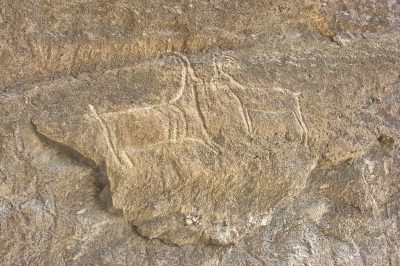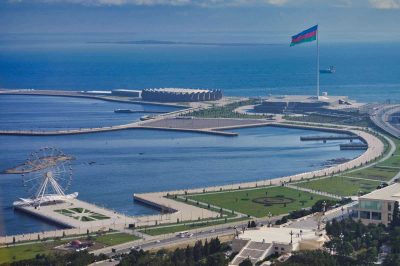The Northwest of Azerbaijan
Northwestern Azerbaijan is located on the southern slopes of the Great Caucasus, whose snow-capped peaks mark the border with Russia. The high mountains, mild climate, and forest greenery make the region one of the most attractive parts of Azerbaijan. Particularly popular destinations include the town of Şəki (Sheki) with its Khan Palace, and the remote mountain village of Lahıc with old coppersmiths and cobblestone alleys. Historically, the region once consisted of three khanates, the large and powerful Şəki, the northern Balakən and the tiny Ilisu.
Şəki (Sheki) – historical town with khans palace and silk factory
Today we would like to introduce you to the city of Şəki in northwestern Azerbaijan. The city is located 350 km west of Baku and has about 64,000 inhabitants. Şəki is probably the oldest city in Azerbaijan and definitely worth a visit. Surrounded by forests, the city of Şəki (pronounced Sheki) spreads out like an amphitheater on the southern foothills of the Great Caucasus. With its mild climate, Khan Palace, silk production, famous sweets, revived wine culture and accommodation in an old caravanserai, it resembles an oriental spa and is ideal as a weekend getaway from Baku, but also for a longer stay.
In July 2019, the Old Town of Sheki and the Khans Palace were included in the UNESCO World Heritage List. Thus, the importance of this historic city is highlighted even more and a trip to Sheki should definitely be on the agenda of a stay in Azerbaijan. Popular destinations in the vicinity of Sheki are the Museum Church in the village of Kiş and Marxal Mountain.
You could go there by train overnight. Although I am a big fan of train travel, I took the bus from Baku, saw some of the countryside, and arrived at the bus station relatively centrally in the city.
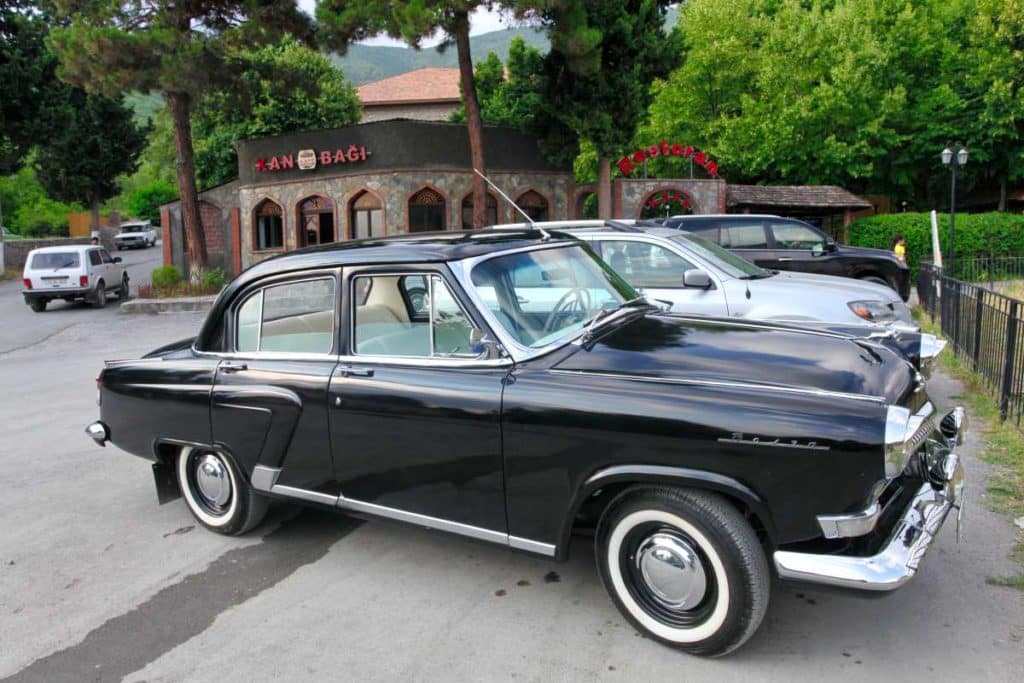
Something about the history of Sheki
The history of Şəki dates back over 2000 years. Before it was annexed by Russia in 1805, Şəki (then Nukha) was the capital of an independent khanate. For its defense, Khan Haci Çeləbi had two forts built. From the more northerly one at Kiş, he defended fiercely against the advancing Persians in the 18th century. According to legend, when Nadir Shah wondered who dared oppose him, Çeləbi replied “Come and see!”, (“Gələrsen görərsən”), which gave the fortress its name, which is still valid today. Sheki itself sank in the floods of the Kiş River in 1772 and was rebuilt as Nukha near the Khan’s second fortress.
It was not until 1968 that Nukha was renamed Şəki again. Three large caravanserais still bear witness to the importance that Şəki once had as a trading center between Dagestan and the trade route running south. Silk (ipek, pronounced “ipeç” in the Şәki dialect) produced in Şəki played a special role, a coveted commodity on the stations of the Silk Road. In the Soviet era, the largest silk factory in the USSR (then Lenin Combine) was established in Şəki with over 7000 workers. After its collapse in the 1990s, silk production has since been revived and is fully functional again. How the scarves and shawls popular with tourists are made can be seen live there by appointment (tel. +994/(0)24/2461847).
Things to see in Sheki
Şəki is an elongated city that becomes increasingly attractive towards the north. Between the bus station and the old town lies the modern center with the bazaar. I have been around the center myself on foot and for longer distances by marshrutka (minibus) or cab.
Discoveries on the way up
From the center, a tranquil path leads along the Quriançay River and attractive old town facades to caravanserais, fortress and palace. However, it does go steeply uphill. A walk there is well sweetened with Şəki’s halva, a pink baklava specialty made of honey and nuts, sold along the river. The best halva store is on the right side of the river, opposite the chess school, in a white house.
The large caravanserais from the 18th and 19th centuries have so far only been partially revived. While one houses a popular hotel, another, next to the Çingiz Club with a cinema and exhibitions, currently sells souvenirs.
It is also worth mentioning the Bio Garden Sheki. This was founded in 2009 and covers 8 hectares. You can find more information here. The owner of the plantation personally guides his guests through his property and explains the fruit varieties. You can also pick and taste fruit. The plantation is also a refuge for ducks, geese and various chicken birds from all over the world.
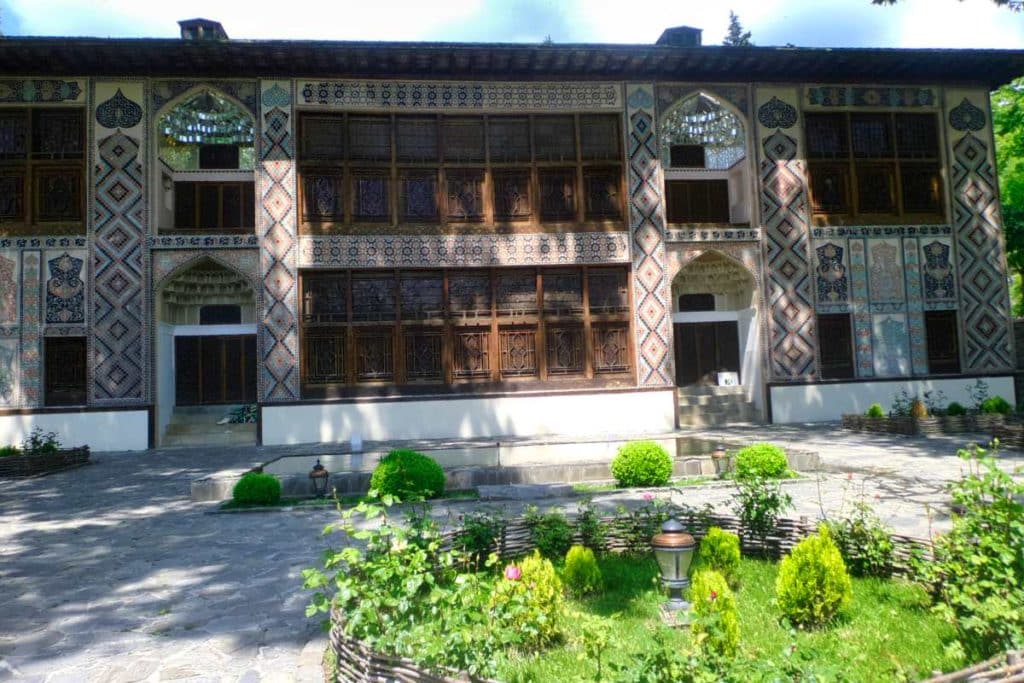
Fortress and Khan Palace
A few minutes walk northeast from the Caravanserai Hotel stands the historic fortress with the palace and numerous museums. The Khan Palace (Xan Saray), probably Şəki’s most famous attraction, was built at the end of the 18th century in Ottoman style and allegedly without a single nail. It was the summer residence of the khans of Şəki. At the same time, the building is surprisingly small, with a depth of just eight meters. It was carefully restored around 2000 under the direction of the Mecklenburg Department for the Preservation of Historical Monuments, and so one can fully indulge in the frenzy of colors of the naively realistic painted residence. A tour allows an interesting insight into the world of the Orient in the Khanate Şəki. Unfortunately, it is not allowed to take pictures or film inside the palace.
The high doorsteps served for thermal insulation, but in the dim light of the colorful Şəbəkə windows they easily tempt one to stumble. The central room on the upper floor is decorated with heroic battle scenes of Çeləbi, while the right room with more flowers and birds served as the chamber of the women from the harem. The balcony offers the best view of an approximately 500-year-old plane tree in the courtyard. The entrance to the palace is allowed only within a guided tour.
Restoration of the Khans Palace
Uwe Henschel from Schwerin was responsible for the restoration of the Khans Palace between 2001 and 2004 as project manager of the Monument Preservation Mecklenburg with funds from the World Bank and the country of Azerbaijan. The project was, of course, an extraordinary challenge for the civil engineer. In those days, even water, gas and electricity were scarce in Şəki. Local construction workers earned about $10 a day at the palace, a large sum in those days and more than the average wage in Azerbaijan. But the effort was worth it, and the Khans’ Palace has been restored to historical detail and is a tourist magnet for the entire region.
Galleries and museums in the palace
Within the fortress walls you will find a simple restaurant (“kafen”) and below it a plush painting gallery with local and national artworks. But it, too, provides a wonderful glimpse into regional Azerbaijani art. In general, many creative people seem to gather in Sheki.
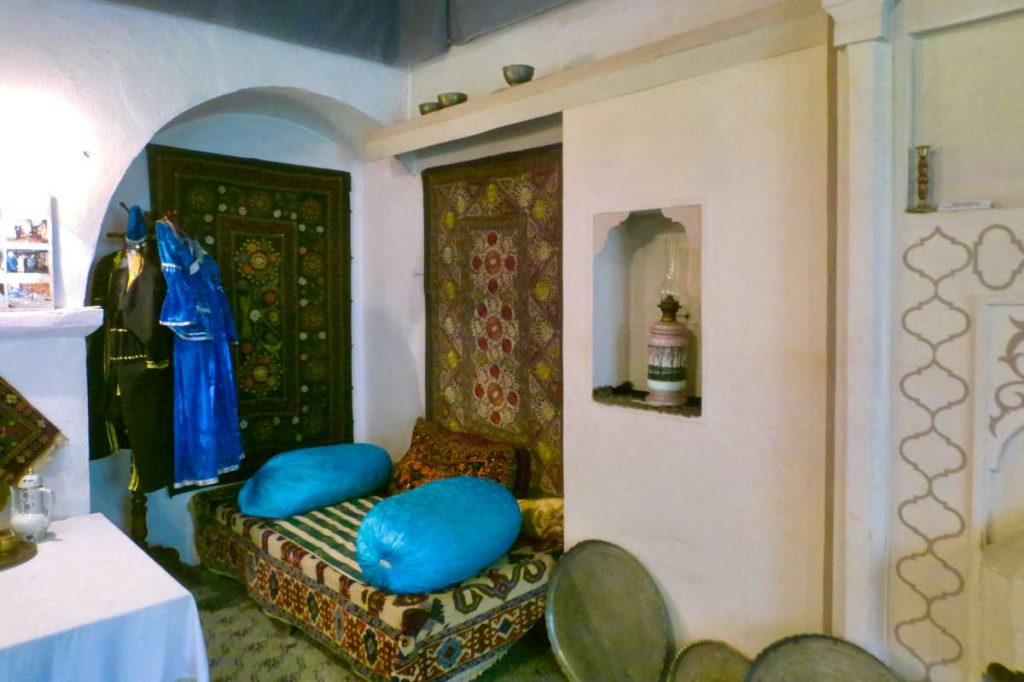
Next door there is an Ethnographic Museum worth seeing, guarded by a whole squad of friendly attendants, with finds from the Gələrsən Görərsən fortress, silk fabric designs, information about the Russian and Soviet times in Şəki, as well as about independence since 1991. The museum also displays carpets, as well as pewter and other metal vessels, glasses, divans, farming tools, paintings – all in all a great insight into centuries of exciting history in and around Şəki. At the exit of the museum you can buy local souvenirs and especially silk scarf products at good prices in a store. Anyway, I bought some silk scarves and other silk products in the museum and the gifted women back in Germany were very happy.
There is also a manageable exhibition of regional carpet designs and embroidery in an old Orthodox garrison church, located to the left of the Ethnographic Museum.

Mir Teymur Mammadov – A Contemporary Artist in Sheki and Baku
In Sheki – below the Khan Palace – an extraordinary Azerbaijani artist has his studio. A row of large and small ceramic figures outside points the way there. But one after the other …
In Baku’s old town, one house in particular stands out in the narrow streets. It is full of artistically designed ceramics. Even when I was in Baku for the first time, I noticed this unique house. Other tourists also stopped in front of it and took selfies. But I didn’t dare to ring the bell there. Like a puzzle, the original ceramics fit together to form a mosaic of Azerbaijani motifs. An artist who decorated every single stone on the walls of his house with different art objects? Original! The historic-looking Turkish tamgas (from Mongolian “stamp”) give the house a special flair. Who might own this house, I often asked myself. Now it is clear: it belongs to the artist Mir Teymur Mammadov, who lives and works in Baku and Şəki.
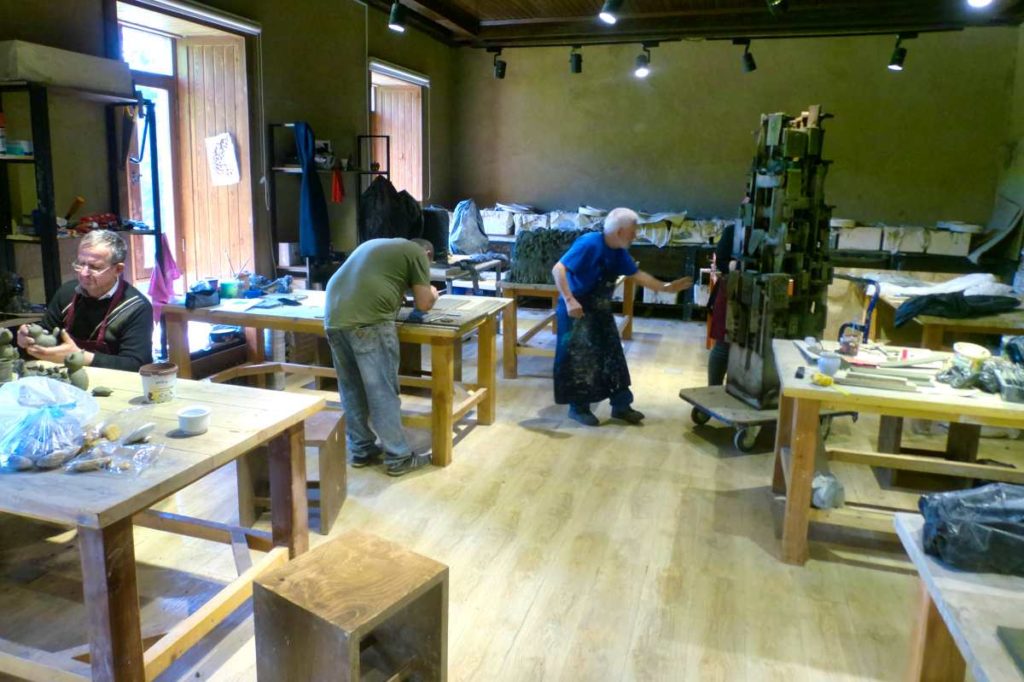
Mammadov’s workshop
In October 2018, Mir Mammadov – in the presence of Azerbaijani President Ilham Aliyev – opened his spacious ceramics workshop in Şəki. Several such artist centers in the country are to follow, the artist, born in 1947, explains in perfect Russian. In May 2019, I visited the artist himself in Şəki in his ceramic workshop. Here you can see Teymur Mammadov’s work for yourself.
In the historic walls of a former barracks, about ten renovated rooms were created: a hall for painting, a hall for ceramics production, a large room with kilns, a spacious kitchen, but also bedrooms for the artists and the boss. The highlight is the store, where all the wonderfully designed exhibits – creative and also exquisite souvenirs – can be admired and bought. Among them are vases with typical Azerbaijani motifs, figurines, paintings, graphics and much more. In the end, everything is artfully packaged by the saleswomen and you can even pay by credit card. If you want, you can sign the guest book, as I did.

The ten or so artists who work and exhibit here include Azerbaijanis from Şəki and Baku, but also Lesgians from Şəki and the surrounding area. Ms. Sevic is a bakinka, “someone from Baku,” who enjoys living and working here in the province. She creates ceramics, especially vases, and smiles happily.
Mammadov speaks Azerbaijani, Russian and some English. He is not shy in front of the media, strangers and tourists. On weekends he is in Baku with his family, but during the week all his heart and soul is devoted to the ceramics workshop in Sheki. For years he had planned, organized, built and made connections for this project. Now his lifelong dream has become a reality. The artist very much regrets that there is no special ceramics museum in Azerbaijan.

Mir began to show interest in ceramic art at the age of five. When his family became aware of his talent, they supported him to the best of their ability. First he graduated from the art school in Baku, then from 1968 to 1978 he studied ceramic art at the Leningrad Art Academy, and during these years he became a specialist in this art form. Mir Teymur has devoted over 60 years of his life to ceramics. His trademark is the old Turkish tamgas and fine dots. In December 2020, I had contact with the artist again and we were both happy to hear from each other, despite Corona.
Mir Teymur, who also works as an ethnographer, researches the history of the Turkic peoples, especially the Azerbaijanis, and reflects their culture, language, alphabet, and mental outlook on his artwork. He is especially fond of clay and ceramics. He wants to pass on his art, his knowledge and the ancient art of the Turkic peoples to the next generation. We wish him success and lots of visitors!
The silk factory of Sheki
If you want to go to the famous silk factory of Sheki, you can go there for example with the marshrutkas and the inscription “İpək fabriki Şəki” (Ipek fabriki Sheki)/ “Шелковая фабрика” or by cab. There is a factory store there for the beautiful silk fabrics. There is also a tobacco factory in Şəki, the Şəki Tütün Fabriki.
Modern shopping temple
In the evening, I took a detour to a new shopping center with an art house cinema in the south of the city, just outside. Similar to the Flame Towers Baku in the national colors of Azerbaijan, the glass facade was also illuminated here. The center is called “ASAN xidmət.” Here, 250 services such as marriage certificates, driver’s licenses and passports are issued unbureaucratically. Everything is equipped with the latest technology. Sometimes you are amazed in Azerbaijan – at the contrasts between rich and poor, between Baku and the provinces, the wealth of ideas and the incredible hospitality.
In the cinema I saw with much muse the Azerbaijani film “Taksi Liza”. A film comedy about a small cab driver, important art – Mona Lisa – and the great love. Because when and where can I see films from Azerbaijan in the cinema in Berlin?

The village of Kish near Sheki with the Albanian Church
Since it was early in the afternoon after all the sightseeing, I wanted to take advantage of the hour and drive to the small village of Kiş above Şəki, which is about 7 km. By chance I saw a cab at a tea room. I asked the driver if we could go to Kiş (pronounced Kish) together. Hassan the cab driver was happy to have a new job. Just the night before last, he had taken a cab with French tourists all the way to Georgia. We conversed fluently in Russian and his gold-tipped teeth showed as he laughed.
Thor Heyerdahl and the renovation of the church
After about 15 min we arrived in Kisch, many signs pointed to the “Albanian Temple” – the old Albanian church. Lovely mountains, paths over two bridges and narrow roads towards the Caucasus led to Kiş. We parked right by the church. A little above there was a monument with the portrait of the Norwegian adventurer, anthropologist, environmental activist and ethnologist Thor Heyerdahl. Some Azerbaijani men were playing Nard, a popular board game, here. Thor Heyerdahl (1914–2002) had been to Azerbaijan many times in the 1980s and found similarities between Vikings and ancestors in Azerbaijan, including petroglyphs in Qobustan south of Baku. The Norwegian also campaigned for the restoration of the Albanian Church in Kiş.
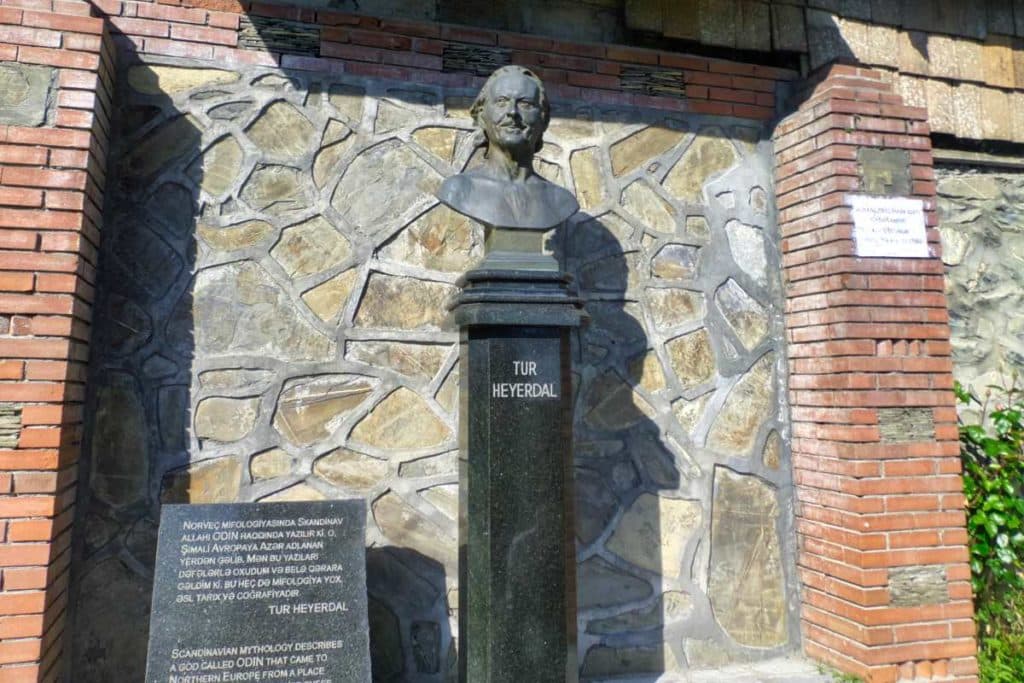
The impressive result can be admired today. With Norwegian support, excavations were carried out in and around the historic church from 2000 to 2003, which indicate that the sanctuary has a history of about 5000 years. The history of early Christianity in Azerbaijan has now been made visible in parts by uncovering graves, among other things. Furthermore, the shape of the church, which was “armenianized ” around 1900, has been reconstructed in favor of its older – Albanian – form from the 12th century. Already in the 5th century the ancient church of St. Elisha was found here.
The “Caucasian Albania”
The “Caucasian Albania” was a kingdom on the territory of modern Azerbaijan, but also in adjacent neighboring countries. Monastery complexes and churches were built from the 5th to the 7th century. For example, “The Seven Churches” (Yeddi Kilse) from the 6th/7th century. In the 12th and 13th centuries the Albanian principalities gained more and more importance. During this period, Grand Prince Hassan Jalal Dovla was crowned King of Albania. All this led to further development of Christian culture and architecture in the region. Evidence of this can be found today mainly in Western Azerbaijan – around Gandja, around Şəki and in Nagorno-Karabakh. Only later Christianity was gradually replaced by Islam in this region. The “Caucasian Albania” is related to today’s Albania in name only, but no more.

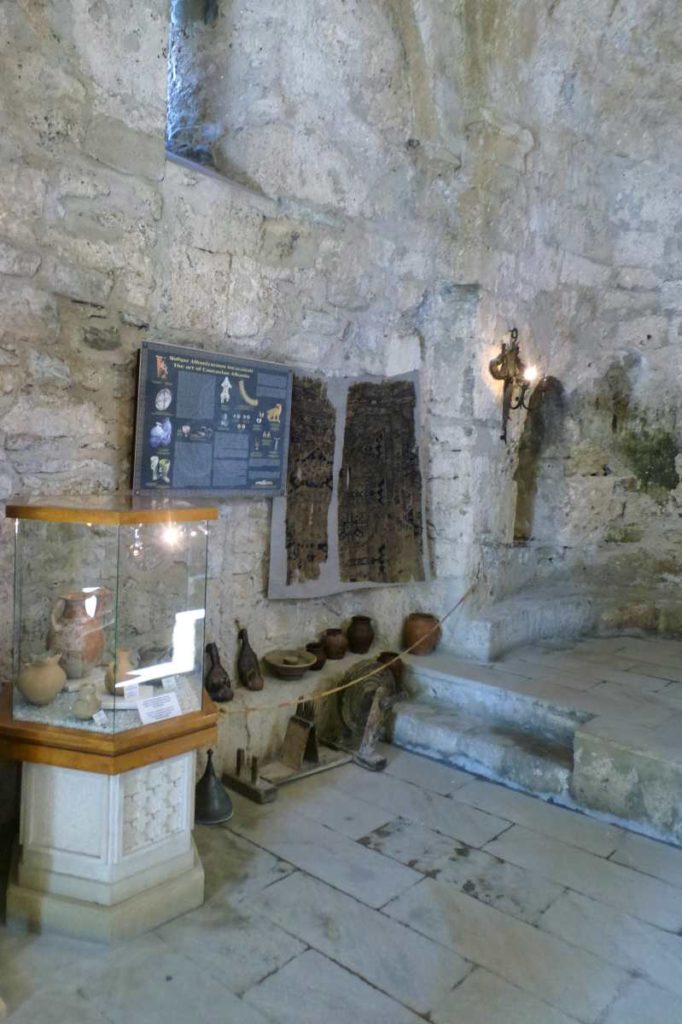
The Church
You can enter the fenced church grounds after paying a small entrance fee. Mrs. Ilhama Hüseynova – she also speaks English and Russian – is the profound connoisseur of the history and present of this museum complex. She is in all the usual travel guides from Lonely Planet to Trescher. She likes to show vases and clay vessels from the excavations and the renovated interior of the church. I am really impressed to see so much history live. Large panels bring the history of this Albanian church to life. Just across the street is Ilhama’s summer restaurant, where drinks, tea and small meals are available at reasonable prices. She can also arrange accommodations on request.
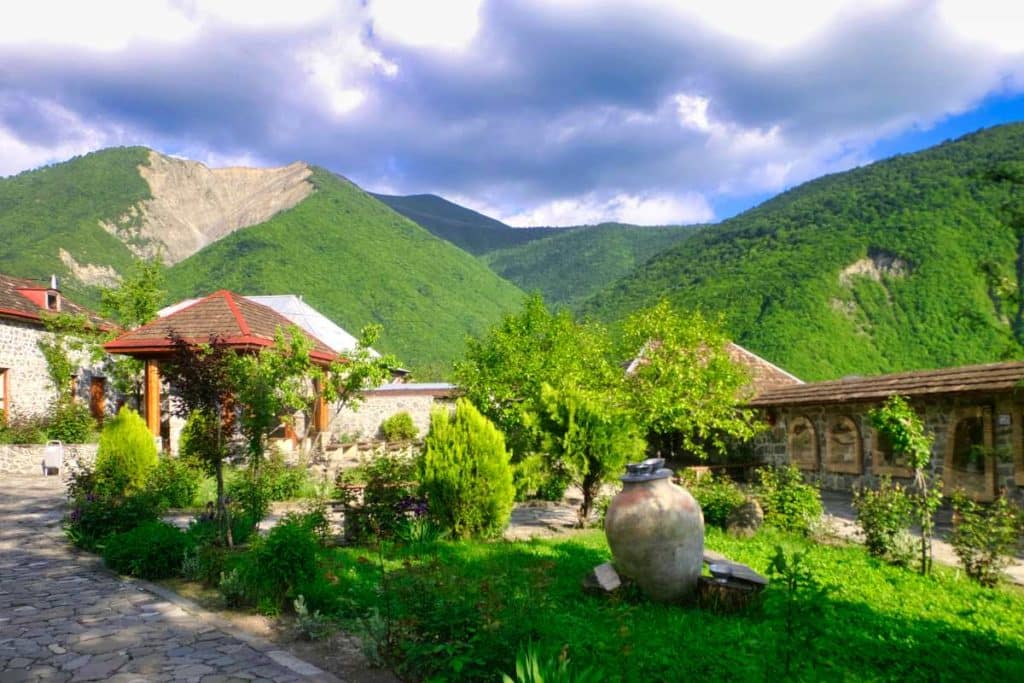
Over tea, I can finally talk longer with Hassan, “my” cab driver. He tells me a lot about life in Azerbaijan, how difficult it was in the 1990s and how much things have improved recently. Many went to Russia to work back then, but have since returned. Of course, cab driving is a tough business, but his German car holds up on the gravel roads in the Azerbaijani mountains. With a little English and especially Russian, he gets by linguistically well.

By the way, “Salam” is the most important word in Azerbaijan for foreigners. With “hello/good day” you will be well received everywhere. And Çay (tea) is always part of life in Azerbaijan, as you would quickly realize (read more about Azerbaijani cuisine here).
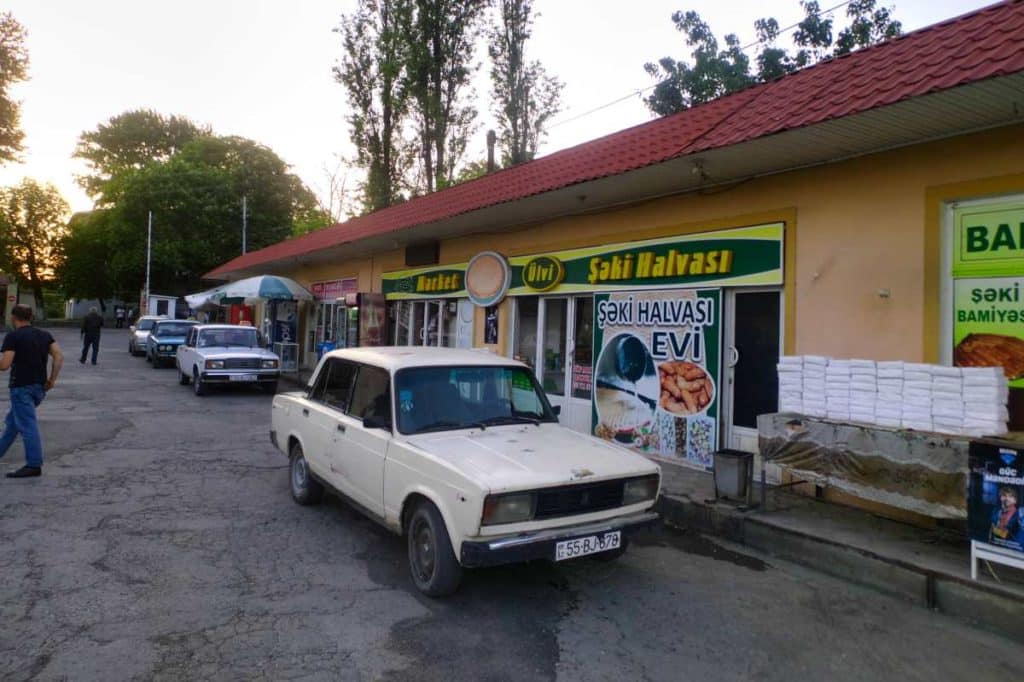
Tourist information Şəki/Sheki
- Tourist information, tel. +994/(0)44/2771340, tic_sheki@tourism.az. The info point is signposted and is located in the fortress at the entrance to the palace, but is only open seasonally.
- The reception of the Şəki Saray Hotel in the city center can be helpful due to better English skills and more courteous service. A moderately good city map is also sold there.
- At the busy bus terminal there is someone at the ticket office who understands English. Marshrutka 11 departs from here to the caravanserai.
- Big buses to Baku leave at 8, 8.30, 9.30, 11, 12, 14, 16 and 17 hrs (352 km, 7 hrs). In between, smaller minibuses drive the route in 4,5-6 hrs with food stop at Şamaxı. From Baku to Şəki you can get 9, 11, 12.20, 14, 16.30, 17.30 23.30 hrs from the bus station. In the morning there are buses to Gəncə and Xaçmaz, twice a day to Qəbələ. By marshrutka you can get to Qax.
- The train station is located about 15 km south of the center. Trains to and from Baku take 8 hours. A convenient option is the night train: from Baku and Şәki 23.20, arrival 7.10 Şәki or Baku. Too bad that the station is so far outside the center.

Hotels
For many years the caravanserai was by far the most popular accommodation in Şəki. In the meantime, the Saray Hotel is considered better. For narrower budgets, the Panorama Hotel, which lives up to its name, is especially recommended.
- Caravanserai, M. F. Axundov küç. 185, phone +994/(0)50/8593982. Historical building with unique ambience. The rooms and especially the bathrooms are partly in need of renovation, in summer you should make a reservation. Reception speaks English.
- Şəki Saray*, Rəsulzadə pr. 187, tel. +994/(0)24/2448181. Comfortable and tastefully furnished, by far the best accommodation of Sheki, free wifi. Book early in the season.
- Panorama Guesthouse, M. F. Axundov küç., in the upper park, tel. +994/(0)50/6229027. Lovingly designed small pension with nice garden and good breakfast. Bathroom separate, but clean and with hot water. Especially in the evening the panoramic view of Şəki is a pleasure with a glass of Çay in the garden.
- Greenhill Inn, M. F. Axundov küç. 14/4, tel. +994/(0)55/5505424. Large hotel with pool and spacious rooms.
- F-Garden (formerly known as Cənnət Baği)*, B. Vahabzade küç. 8. Unfortunately a bit off the track, but idyllically located on the outskirts of town; best reached by cab. Beautiful complex with lots of greenery. 31 rooms of medium standard, separate houses. At breakfast great view from the terrace to the Great Caucasus. Very cordial family-run hotel with gifted chef. Money exchange, air conditioning, Wi-Fi, a pool is still to be built.
Restaurants
- Caravanserai. You can dine idyllically in the courtyard between rose beds. The food is good, the menu is partly in English. Especially delicious is kartof dolmacı with yogurt and salad, accompanied by tea with rose jam. Live music in the evening, but no alcohol. The oriental tea room (çay evi) offers an overpriced “menu” with halva, tea and hookah.
- Restaurant at Şəki Saray. Especially the dinner with jazz music is highly praised. At noon there is classical music. Popular and with a good assortment is the bar (partly open until 1/2 o’clock at night).
- There are summer restaurants in the lower city park. Other places to stop are located around the central square.
- Celebixon. Popular restaurant, 1 min. from the central square. You can sit nicely outside, also in separees, and enjoy oriental flair with fountain.
- The Çingiz Club offers exhibitions and films, sometimes English-Azerbaijani.
- Alahmad is the best halva store. On the right side of the river, simple white building opposite the chess club.
Practical information Kiş/Kish
- Buses 15 and 23 depart from the bazaar in Sheki, stopping at the north side of the central square, to Kish. However, due to long waiting times, it is more advisable to take a cab or walk.
- Opposite the church Ilhama Hüseynova offers accommodation and in her small summer pub food and drinks (tel. +994/(0)50/6310246). Ilhama also takes care of the Albanian Church area with entrance, kiosk, souvenirs as well as expert information.
- Also Ilham Ağayev offers two private rooms right by the church with shower in the garden. Little English, tel. +994/(0)24/2498417.
- Marxal Resort*, Tel. +994/(0)50/3194040. Prices vary depending on the standard. In a quiet, wooded location on the river, with good food, billiards and tennis.
- Şəki Park*, near Kish. Beautiful small bungalow complex. Opulent breakfast buffet. Well-kept pool area with a view of the Great Caucasus. Great restaurant with reasonable prices.

Your opinion
How did you like the article? Feel free to leave a comment and follow us on Facebook for more stories!


